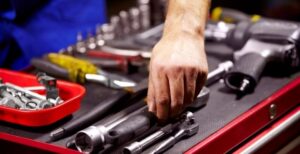August
Hand Tool Inspections
There are many injuries while using hand tools on the job. Many of these injuries occur from improper use, but there are also injuries that involve a tool that was broken or in need of repair. What tool is being used will decide what needs to be inspected on it.
Common hand tools found on almost every job site and at home across the country are screwdrivers, hammers, chisels, and wrenches. This is not an all-inclusive list, but these are some of the most commonly used hand tools.
Common Hand Tool Inspection Items
Hammers – Ensure that the handle is not broken or chipped. If a handle is taped, more than likely it is broken and needs to be replaced. On any tool, tape is not a manufacturer’s approved fix for a needed repair. Ensure the head of the hammer is tight on the handle. Throw the hammer away if part of the claw is broken off.
Screwdrivers – Ensure the handle is not chipped or broken. Many people will use the screwdriver as a chisel and hit the back end of it with a hammer. This causes damage to the screwdriver and will damage the handle. If the head of the screwdriver is chipped or worn down, replace the screwdriver.
Chisels – Chisels are strong tools, but just like any other tool, they will begin to break down over time. Check the back of the chisel. Often times, the back will begin to mushroom. When mushrooming occurs, the chisel either needs to be repaired properly or replaced.
Wrenches – Check that the wrench is not bent. Replace any wrench that is chipped or excessively worn. Losing the grip on a bolt due to a worn or broken wrench can easily cause hand injuries to the user.
When and how should you inspect powered hand tools?
- Inspect tools for any damage prior to each use.
- Check the handle and body casing of the tool for cracks or other damage.
- If the tool has auxiliary or double handles, check to see that they installed securely.
- Inspect cords for defects: check the power cord for cracking, fraying, and other signs of wear or faults in the cord insulation.
- Check for damaged switches and ones with faulty trigger locks.
- Inspect the plug for cracks and for missing, loose or faulty prongs.
What should you do if you find a tool defective?
- If a tool is defective, remove it from service, and tag it clearly “Out of service for repair.”
- Replace damaged equipment immediately – do not use defective tools “temporarily.”
- Have tools repaired by a qualified person – do not attempt field repairs.
What should you do before using powered hand tools?
- Ensure that you have been properly trained to use the tool safely. Read the operator’s manual before using the tool and operate the tool according to the manufacturer’s instructions. Use only tested and approved tools.
- Ensure that the power tool has the correct guard, shield or other attachment that the manufacturer recommends.
- Prevent shocks. Ensure that the tools are properly grounded using a three-prong plug, are double-insulated (and are labelled as such), or are powered by a low-voltage isolation transformer: this will protect users from an electrical shock.
- Check electric tools to ensure that a tool with a 3-prong plug has an approved 3-wire cord and is grounded. The three-prong plug should be plugged in a properly grounded 3-pole outlet. If an adapter must be used to accommodate a two-hole receptacle, the adapter wire must be attached to a known, functioning ground. NEVER remove the third, grounding prong from a plug.
- Replace open front plugs with dead front plugs. Dead front plugs are sealed and present less danger of shock or short circuit.
- Have a qualified electrician install a polarized outlet if the polarized, two-prong plug of a double-insulated tool does not fit in a two-hole receptacle. Double insulated tools use plugs having one prong that is visibly wider than the other.
- Test all tools for effective grounding with a continuity tester or a ground fault circuit interrupter (GFCI) before use.
- Use only the kind of battery that the tool manufacturer specifies for the battery-powered tool that you are using.
- Recharge a battery-powered tool only with a charger that is specifically intended for the battery in that tool.
- Remove the battery from the tool or ensure that the tool is switched off or locked off before changing accessories, making adjustments, or storing the tool.
- Store a battery pack safely so that no metal parts, nails, screws, wrenches and so on can come in contact with the battery terminals; this could result in shorting the battery and possibly cause sparks, fires or burns.
Sources:
https://www.ccohs.ca/oshanswers/safety_haz/power_tools/saf_elec.html
https://www.safetytalkideas.com/safetytalks/hand-tool-inspections/

